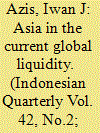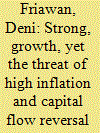| Srl | Item |
| 1 |
ID:
133563


|
|
|
|
|
| Publication |
2014.
|
| Summary/Abstract |
In contrast with the pre~1997/98, today's emerging Asia registers excess savings. Since early 2000s, the liquidity was further boosted by in?ows of capital including those going through the banking sector. After a brief, yet sharp, interruption at the beginning of the global ?nancial crisis, in?ows resumed albeit of different form and inducted by different agents. Nonetheless, the global liquidity sphere has clearly changed. When the quantitative easing tantrum began in May last year, volatility returned. Largely due to a lack of innovative policy response, the episode of vacillating flows produced repercussions not different than in the past because the incentive system remains unchanged. Consequendy, vulnerability still rises with capital ?ows. The 'rational' response of agents is equally predictable, raising the risk of financial instability and exacerbating the already widening income disparity. Nothing is fundamentally new, everyone continues to "dance with the system."
|
|
|
|
|
|
|
|
|
|
|
|
|
|
|
|
| 2 |
ID:
047154


|
|
|
|
|
| Publication |
London, Zed Books Ltd., 2001.
|
| Description |
xlii, 321p.
|
| Standard Number |
1842770225
|
|
|
|
|
|
|
|
|
|
|
|
Copies: C:1/I:0,R:0,Q:0
Circulation
| Accession# | Call# | Current Location | Status | Policy | Location |
| 044622 | 330.9595/JOM 044622 | Main | On Shelf | General | |
|
|
|
|
| 3 |
ID:
100259


|
|
|
|
|
| Publication |
2010.
|
| Summary/Abstract |
The paper sets up a small open economy general equilibrium model to study the dynamics of the adjustment of trade imbalances under different policies based on the Chinese economy. The policies that adjust domestic prices require a long period to achieve trade balance and induce fluctuations of output and inflation, regardless of whether capital markets are open or closed, while policies that adjust the exchange rate quickly result in diminished trade surpluses, and do not cause fluctuations of output and inflation. However, policies that adjust the exchange rate slowly also lead to fluctuations under a capital flow setting. Nominal frictions are important factors to these differences, because they slow down the price adjustment, but do not bother the exchange rate changes. From the perspective of welfare, fast exchange rate adjustment policies are better than price policies, and adjustment under capital flow is better than adjustment under capital control. The implications for China's trade surplus are analyzed.
|
|
|
|
|
|
|
|
|
|
|
|
|
|
|
|
| 4 |
ID:
101939


|
|
|